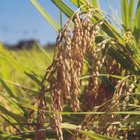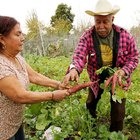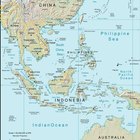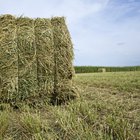
Staple foods are foods that are eaten regularly enough to produce energy and nutrients. In terms of energy, the United Nations lists the average African diet as 46 percent cereals, 20 percent roots and tubers, and 7 percent animal products. Staple foods that grow in Africa have to be able to thrive in nutrient poor soil and withstand drought and very hot weather. Several humanitarian groups are working to help small farmers in Africa enhance local crops to provide more food and cash to meet family needs.
Millet and Sorghum
The primary cereal staple in Africa is millet. The advantages of growing millet are that it is drought resistant, keeps well and, according to the Vegetarian Society, contains higher levels of protein and iron than many other cereals. The second most important cereal crop is sorghum, a corn-like grain with waxy leaves that is well suited to the subtropical and arid climates of Africa. Sorghum is drought resistant and has 90 percent of the nutritional value of corn. Rice and maize are also important staples. The International Institute of Tropical Agriculture (IITA) has developed intercropping methods of cowpeas and cereal crops because cowpeas fix the nitrogen need in poor soils.
Cassava
IITA lists cassava as a security crop because the roots can be stored in the ground for two to three years and it can be grown in nutrient poor soils. It has starchy roots that can be eaten boiled or raw, or made into flour or paste. Cassava leaves are eaten as a green vegetable and are a good source of protein and vitamins A and B. Africa produces 54 percent of the world's cassava crops. Itai Madamombe, writer for "Africa Renewal," states that many families are turning from planting maize to planting cassava because it does not wither as quickly in drought conditions, and harvests are more available in historic times of hunger like the beginning of the rainy season.
Groundnuts
Groundnuts, also called peanuts or bambara nuts, are important sources of fats, carbohydrates and protein and are grown throughout many developing nations. The tubers are dried or roasted and used to make soups, flour and porridge. In western Africa, groundnuts are highly valued by women because they can use some of the cash profits to send their children to school. In addition, groundnuts are good sources of energy and protein for their children, as well as good sources for cooking oil and everyday food. Scientists at Michigan Technology Institute report that many humanitarian agencies are working to expand groundnut production as a way to solve malnutrition and empower women.
Yams
Yams are an important staple crop in Africa because they can be stored for up to 6 months without refrigeration, and according to the Global Crop Diversity Trust, they serve as a good safety net between growing seasons. Yams are high in vitamin A and carotenoids, important antioxidants in human nutrition. IITA is working closely with Nigerian researchers to come up with new ways of yam seed production.
Related Articles

Uses of Cassava Flour

Uses of Sorghum

What Additives Are in Flour?

The Mayan Diet

Neolithic Diets

Southeast Asian Diet & Nutrition

What Is White Oat?

Alfalfa Hay Nutrition Information

Advantages & Disadvantages of Natural ...

About Seaweed and Hair Growth

Characteristics of Polyester & Cotton

Quinoa Vs. Chicken

The Effects of Organic Fertilizer on ...

Benefits of GMO Foods

Which Nuts Are Alkaline Forming?

What Are the Uses of Vermicompost?

Essential Enzymes for Hair Growth

How to Cook Winter Root Vegetables in a ...

The Nutrition of 15-Bean Soup

What Countries Harvest Pearls?